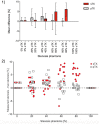Effects of image homogeneity on stenosis visualization at 7 T in a coronary artery phantom study: With and without B1-shimming and parallel transmission
- PMID: 35767553
- PMCID: PMC9242506
- DOI: 10.1371/journal.pone.0270689
Effects of image homogeneity on stenosis visualization at 7 T in a coronary artery phantom study: With and without B1-shimming and parallel transmission
Abstract
Background: To investigate the effects of B1-shimming and radiofrequency (RF) parallel transmission (pTX) on the visualization and quantification of the degree of stenosis in a coronary artery phantom using 7 Tesla (7 T) magnetic resonance imaging (MRI).
Methods: Stenosis phantoms with different grades of stenosis (0%, 20%, 40%, 60%, 80%, and 100%; 5 mm inner vessel diameter) were produced using 3D printing (clear resin). Phantoms were imaged with four different concentrations of diluted Gd-DOTA representing established arterial concentrations after intravenous injection in humans. Samples were centrally positioned in a thorax phantom of 30 cm diameter filled with a custom-made liquid featuring dielectric properties of muscle tissue. MRI was performed on a 7 T whole-body system. 2D-gradient-echo sequences were acquired with an 8-channel transmit 16-channel receive (8 Tx / 16 Rx) cardiac array prototype coil with and without pTX mode. Measurements were compared to those obtained with identical scan parameters using a commercially available 1 Tx / 16 Rx single transmit coil (sTX). To assess reproducibility, measurements (n = 15) were repeated at different horizontal angles with respect to the B0-field.
Results: B1-shimming and pTX markedly improved flip angle homogeneity across the thorax phantom yielding a distinctly increased signal-to-noise ratio (SNR) averaged over a whole slice relative to non-manipulated RF fields. Images without B1-shimming showed shading artifacts due to local B1+-field inhomogeneities, which hampered stenosis quantification in severe cases. In contrast, B1-shimming and pTX provided superior image homogeneity. Compared with a conventional sTX coil higher grade stenoses (60% and 80%) were graded significantly (p<0.01) more precise. Mild to moderate grade stenoses did not show significant differences. Overall, SNR was distinctly higher with B1-shimming and pTX than with the conventional sTX coil (inside the stenosis phantoms 14%, outside the phantoms 32%). Both full and half concentration (10.2 mM and 5.1 mM) of a conventional Gd-DOTA dose for humans were equally suitable for stenosis evaluation in this phantom study.
Conclusions: B1-shimming and pTX at 7 T can distinctly improve image homogeneity and therefore provide considerably more accurate MR image analysis, which is beneficial for imaging of small vessel structures.
Conflict of interest statement
The authors have declared that no competing interests exist.
Figures






Similar articles
-
Optimized radiofrequency shimming using low-heating B1+-mapping in the presence of deep brain stimulation implants: Proof of concept.PLoS One. 2024 Dec 18;19(12):e0316002. doi: 10.1371/journal.pone.0316002. eCollection 2024. PLoS One. 2024. PMID: 39693369 Free PMC article.
-
Fast and accurate multi-channel B1+ mapping based on the TIAMO technique for 7T UHF body MRI.Magn Reson Med. 2018 May;79(5):2652-2664. doi: 10.1002/mrm.26925. Epub 2017 Oct 9. Magn Reson Med. 2018. PMID: 28994132
-
Cardiac imaging at 7 Tesla: Single- and two-spoke radiofrequency pulse design with 16-channel parallel excitation.Magn Reson Med. 2013 Nov;70(5):1210-9. doi: 10.1002/mrm.24935. Epub 2013 Sep 10. Magn Reson Med. 2013. PMID: 24038314 Free PMC article.
-
A review of recent developments and applications of high-permittivity dielectric shimming in magnetic resonance.NMR Biomed. 2024 Apr;37(4):e5094. doi: 10.1002/nbm.5094. Epub 2024 Jan 12. NMR Biomed. 2024. PMID: 38214202 Review.
-
Recent Advances in Radio-Frequency Coil Technologies: Flexible, Wireless, and Integrated Coil Arrays.J Magn Reson Imaging. 2022 Apr;55(4):1026-1042. doi: 10.1002/jmri.27865. Epub 2021 Jul 29. J Magn Reson Imaging. 2022. PMID: 34324753 Free PMC article. Review.
Cited by
-
Report from the society of magnetic resonance angiography: clinical applications of 7T neurovascular MR in the assessment of intracranial vascular disease.J Neurointerv Surg. 2024 Jul 16;16(8):846-851. doi: 10.1136/jnis-2023-020668. J Neurointerv Surg. 2024. PMID: 37652689 Free PMC article. Review.
References
-
- Task Force Members, Montalescot G, Sechtem U, Achenbach S, Andreotti F, Arden C, et al.. 2013 ESC guidelines on the management of stable coronary artery disease: the Task Force on the management of stable coronary artery disease of the European Society of Cardiology. European Heart Journal. 2013. pp. 2949–3003. doi: 10.1093/eurheartj/eht296 - DOI - PubMed
-
- Fihn SD, Gardin JM, Abrams J, Berra K, Blankenship JC, Dallas AP, et al.. 2012 ACCF/AHA/ACP/AATS/PCNA/SCAI/STS guideline for the diagnosis and management of patients with stable ischemic heart disease: a report of the American College of Cardiology Foundation/American Heart Association task force on practice guidelines, and the American College of Physicians, American Association for Thoracic Surgery, Preventive Cardiovascular Nurses Association, Society for Cardiovascular Angiography and Interventions, and Society of Thoracic Surgeons. 11 ed. Circulation. 2012. pp. e354–471. doi: 10.1161/CIR.0b013e318277d6a0 - DOI - PubMed
-
- Liu X, Zhao X, Huang J, Francois CJ, Tuite D, Bi X, et al.. Comparison of 3D free-breathing coronary MR angiography and 64-MDCT angiography for detection of coronary stenosis in patients with high calcium scores. AJR Am J Roentgenol. American Roentgen Ray Society; 2007;189:1326–32. doi: 10.2214/AJR.07.2805 - DOI - PMC - PubMed
Publication types
MeSH terms
LinkOut - more resources
Full Text Sources

